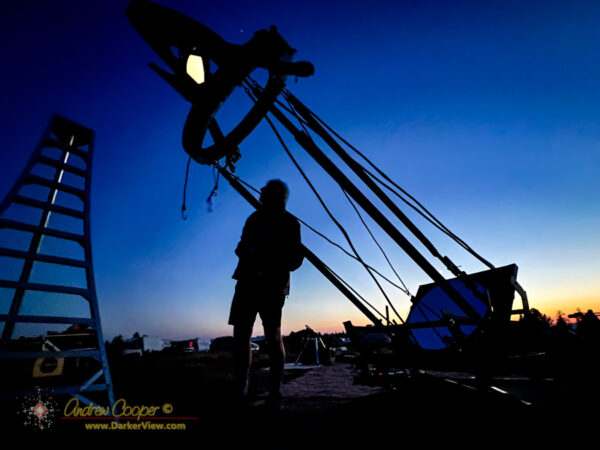
Kilauea Rainforest

When you want to see the stars, find someplace dark

One of the things I brought back from Oregon Star Party was a set of solar filters for binoculars.
The filters were from DayStar Filters who had a booth at the star party. I spent a while chatting with the gal running the booth and enjoying the hydrogen alpha views through the ‘scope they had set-up. The Daystar SS60 Hydrogen alpha ‘scope they had on sale was rather tempting.
Continue reading “Binocular Solar Filter”A dark clear night at Kaʻohe, just the thing I needed. A telescope… A dark sky.
There had been plans of a few friends from work, but with a virus rampaging through the crew a social event did not seem like a great idea. Will have to do the invitations another time. This evening would be a solo run.
No big production… Toss the gear in the vehicle… The Nexstar 11″ ‘scope, a few munchies and a thermos of hot tea, a table, a notebook, and go.
The night was nearly perfect, no wind, not all that cold, a few wisps of cloud that dissipated after sunset.
I would work the southern horizon this night, as low as I can go from 20°N latitude. From the Kaʻohe site due south is right over the summit of Mauna Loa. Just above the shadowy outline of the caldera I would catch stars and galaxies as they transited. Constellations unknown and inaccessible to northern observers… Pavo, Grus, and Phoenix. Some of the objects I observed were in the lower -60° declinations…
φ2 Pav Pale yellow, no companion noted, φ1 Pav is visible 33′ west
Andrew Cooper, 7 Oct 2023
NGC 7582 Bright and obvious, extended 5′ x 2′ northwest-southeast, brighter to the center without a notable core, NGC 7590 and NGC 7599 visible 10′ northeast, NGC 7552 visible 28′ southwest, the Grus Quartet makes an entrancing field with four bright galaxies
NGC 45 Quite faint and diffuse, difficult, about 5′ diameter, a slight brightening to the center, a 10th magnitude star in the southeast quadrant, the 7th magnitude star HD 941 is about 5′ southwest
NGC 7155 Small, faint, round with a stellar core, at the center of an east-west 15′ arc of 11th to 12th magnitude stars
A good night out with a telescope, packing it in about midnight as to not totally wreck my sleep pattern. Still, I got in five hours of observing.
Yes, she is rumbling again, mere weeks after the last eruption ended.
Inflation at the summit has surged with a vengence, the pressure under the caldera right back to where it was at the start of the September eruption. A persistent pattern of earthquakes rumbles beneath the southwestern flank indicating intruding magma.
The USGS has noticed, they are back to issuing daily reports. The park service has noticed, trails in the southwestern rift zone have been closed. Local photographers have noticed, plans are ready to spring into action with grab-and-go bags of photo gear by the door.
Leaking alkaline batteries, the bane of our portable, battery powered existence. All too many times I have found myself repairing electronic devices damage by leaking batteries, or just junking the gear when the damage is too severe.
This time the device in question was just a bit too valuable to dispose of despite fairly extensive damage.
A Celestron Nexstar 8SE telescope.
Continue reading “Battery Corrosion Again”
